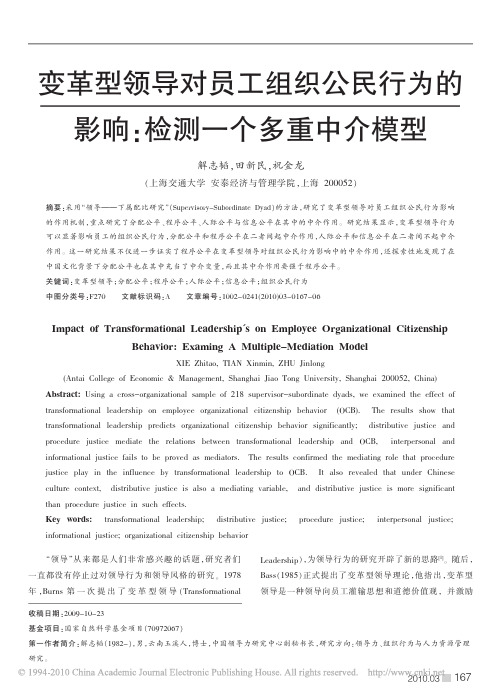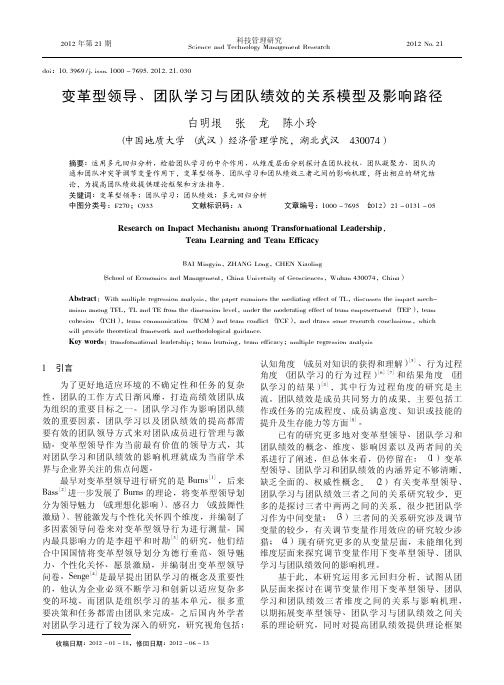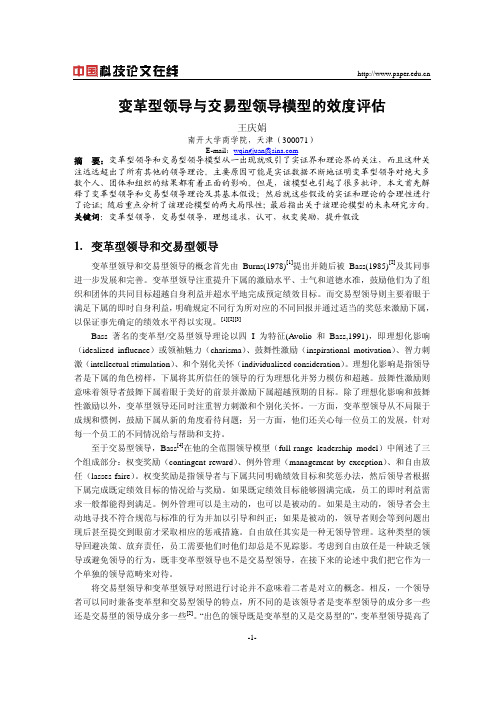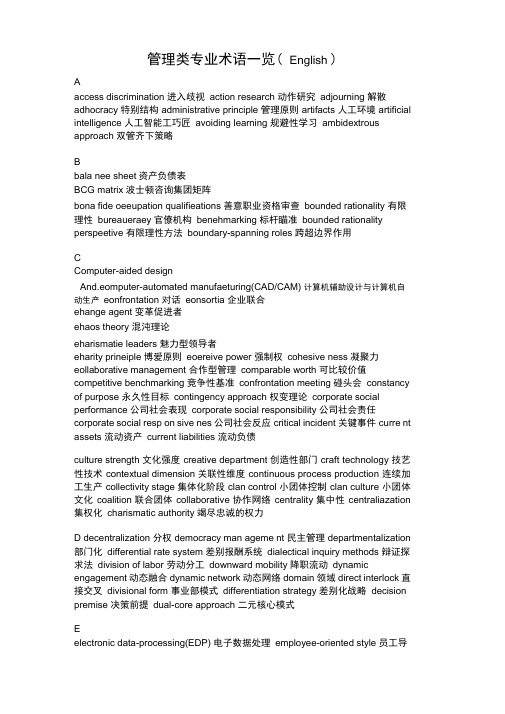Transformational Leadership Scale 变革型领导量表
- 格式:docx
- 大小:14.37 KB
- 文档页数:2

“领导”从来都是人们非常感兴趣的话题,研究者们一直都没有停止过对领导行为和领导风格的研究。
1978年,Burns第一次提出了变革型领导(Transformational Leadership),为领导行为的研究开辟了新的思路[1]。
随后,Bass(1985)正式提出了变革型领导理论,他指出,变革型领导是一种领导向员工灌输思想和道德价值观,并激励变革型领导对员工组织公民行为的影响:检测一个多重中介模型解志韬,田新民,祝金龙(上海交通大学安泰经济与管理学院,上海200052)摘要:采用“领导———下属配比研究”(Supervisory-Subordinate Dyad)的方法,研究了变革型领导对员工组织公民行为影响的作用机制,重点研究了分配公平、程序公平、人际公平与信息公平在其中的中介作用。
研究结果显示,变革型领导行为可以显著影响员工的组织公民行为,分配公平和程序公平在二者间起中介作用,人际公平和信息公平在二者间不起中介作用。
这一研究结果不仅进一步证实了程序公平在变革型领导对组织公民行为影响中的中介作用,还探索性地发现了在中国文化背景下分配公平也在其中充当了中介变量,而且其中介作用要强于程序公平。
关键词:变革型领导;分配公平;程序公平;人际公平;信息公平;组织公民行为中图分类号:F270文献标识码:A文章编号:1002-0241(2010)03-0167-06Impact of Transformational Leadership's on Employee Organizational CitizenshipBehavior:Examing A Multiple-Mediation ModelXIE Zhitao,TIAN Xinmin,ZHU Jinlong(Antai College of Economic&Management,Shanghai Jiao Tong University,Shanghai200052,China) Abstract:Using a cross-organizational sample of218supervisor-subordinate dyads,we examined the effect of transformational leadership on employee organizational citizenship behavior(OCB).The results show that transformational leadership predicts organizational citizenship behavior significantly;distributive justice and procedure justice mediate the relations between transformational leadership and OCB,interpersonal and informational justice fails to be proved as mediators.The results confirmed the mediating role that procedure justice play in the influence by transformational leadership to OCB.It also revealed that under Chinese culture context,distributive justice is also a mediating variable,and distributive justice is more significant than procedure justice in such effects.Key words:transformational leadership;distributive justice;procedure justice;interpersonal justice;informational justice;organizational citizenship behavior收稿日期:2009-10-23基金项目:国家自然科学基金项目(70972067)第一作者简介:解志韬(1982-),男,云南玉溪人,博士,中国领导力研究中心副秘书长,研究方向:领导力、组织行为与人力资源管理研究。

2012年第21期科技管理研究Science and Technology Management Research2012No.21收稿日期:2012-01-18,修回日期:2012-06-13doi :10.3969/j.issn.1000-7695.2012.21.030变革型领导、团队学习与团队绩效的关系模型及影响路径白明垠,张龙,陈小玲(中国地质大学(武汉)经济管理学院,湖北武汉430074)摘要:运用多元回归分析,检验团队学习的中介作用,从维度层面分别探讨在团队授权、团队凝聚力、团队沟通和团队冲突等调节变量作用下,变革型领导、团队学习和团队绩效三者之间的影响机理,得出相应的研究结论,为提高团队绩效提供理论框架和方法指导。
关键词:变革型领导;团队学习;团队绩效;多元回归分析中图分类号:F270;C933文献标识码:A 文章编号:1000-7695(2012)21-0131-05Research on Impact Mechanism among Transformational Leadership ,Team Learning and Team EfficacyBAI Mingyin ,ZHANG Long ,CHEN Xiaoling(School of Economics and Management ,China University of Geosciences ,Wuhan 430074,China )Abstract :With multiple regression analysis ,the paper examines the mediating effect of TL ,discusses the impact mech-anism among TFL ,TL and TE from the dimension level ,under the moderating effect of team empowerment (TEP ),team cohesion (TCH ),team communication (TCM )and team conflict (TCF ),and draws some research conclusions ,which will provide theoretical framework and methodological guidance.Key words :transformational leadership ;team learning ,team efficacy ;multiple regression analysis1引言为了更好地适应环境的不确定性和任务的复杂性,团队的工作方式日渐风靡,打造高绩效团队成为组织的重要目标之一。

优秀管理者的管理风格
1. Situational Leadership Style(情境领导风格)
此风格适用于不同的团队和不同情况下的领导方式,依据员工的
工作能力、技能、动机和才能,选择不同的领导方法来达到最佳的结果。
这种风格非常灵活,能够适应变化。
2. Transformational Leadership Style(变革型领导风格)
这种风格的管理者可以激发员工的内在动力和潜力,使其超越自我,追求更高的目标。
这种风格的管理者会鼓励员工创新、创造,并
且不断地提供支持和鼓励,帮助员工发挥出最大的潜力。
3. Coaching Leadership Style(教练型领导风格)
教练型领导风格的管理者会倾听员工的想法和观点,指导员工如
何做出正确的决策,并且会为员工提供帮助和支持。
这种风格的管理
者会建立和员工之间的相互信任和合作,使员工能够不断发展和成长。
4. Democratic Leadership Style(民主型领导风格)
这种风格的管理者会鼓励员工参与决策,给员工更多的自主权和
责任,建立一个团队合作的氛围。
这种风格的管理者会倾听员工的意
见和建议,并且会为员工提供支持和帮助。
5. Servant Leadership Style(仆人型领导风格)
这种风格的管理者认为自己是为团队服务的,他们会尽力满足员
工的需求和期望,并且会为员工提供支持和鼓励。
这种风格的管理者
会倾听员工的意见和建议,并且会为员工提供帮助和指导。
同时,这
种领导风格还注重员工的发展和成长。


变革型领导与交易型领导模型的效度评估王庆娟南开大学商学院,天津(300071)E-mail:wqingjuan@摘要:变革型领导和交易型领导模型从一出现就吸引了实证界和理论界的关注,而且这种关注远远超出了所有其他的领导理论。
主要原因可能是实证数据不断地证明变革型领导对绝大多数个人、团体和组织的结果都有着正面的影响。
但是,该模型也引起了很多批评。
本文首先解释了变革型领导和交易型领导理论及其基本假设;然后就这些假设的实证和理论的合理性进行了论证;随后重点分析了该理论模型的两大局限性;最后指出关于该理论模型的未来研究方向。
关键词:变革型领导,交易型领导,理想追求,认可,权变奖励,提升假设1.变革型领导和交易型领导变革型领导和交易型领导的概念首先由Burns(1978)[1]提出并随后被Bass(1985)[2]及其同事进一步发展和完善。
变革型领导注重提升下属的激励水平、士气和道德水准,鼓励他们为了组织和团体的共同目标超越自身利益并超水平地完成预定绩效目标。
而交易型领导则主要着眼于满足下属的即时自身利益,明确规定不同行为所对应的不同回报并通过适当的奖惩来激励下属,以保证事先确定的绩效水平得以实现。
[1][2][3]Bass著名的变革型/交易型领导理论以四I为特征(Avolio和Bass,1991),即理想化影响(idealized influence)或领袖魅力(charisma)、鼓舞性激励(inspirational motivation)、智力刺激(intellectual stimulation)、和个别化关怀(individualized consideration)。
理想化影响是指领导者是下属的角色榜样,下属将其所信任的领导的行为理想化并努力模仿和超越。
鼓舞性激励则意味着领导者鼓舞下属着眼于美好的前景并激励下属超越预期的目标。
除了理想化影响和鼓舞性激励以外,变革型领导还同时注重智力刺激和个别化关怀。

管理类专业术语一览( English )Aaccess discrimination 进入歧视action research 动作研究adjourning 解散adhocracy 特别结构administrative principle 管理原则artifacts 人工环境artificial intelligence 人工智能工巧匠avoiding learning 规避性学习ambidextrous approach 双管齐下策略Bbala nee sheet资产负债表BCG matrix 波士顿咨询集团矩阵bona fide oeeupation qualifieations 善意职业资格审查bounded rationality 有限理性bureaueraey 官僚机构benehmarking 标杆瞄准bounded rationality perspeetive 有限理性方法boundary-spanning roles 跨超边界作用CComputer-aided designAnd.eomputer-automated manufaeturing(CAD/CAM) 计算机辅助设计与计算机自动生产eonfrontation 对话eonsortia 企业联合ehange agent 变革促进者ehaos theory 混沌理论eharismatie leaders 魅力型领导者eharity prineiple 博爱原则eoereive power 强制权cohesive ness 凝聚力eollaborative management 合作型管理comparable worth 可比较价值competitive benchmarking 竞争性基准confrontation meeting 碰头会constancy of purpose 永久性目标contingency approach 权变理论corporate social performance 公司社会表现corporate social responsibility 公司社会责任corporate social resp on sive nes公司社会反应critical incident 关键事件curre nt assets 流动资产current liabilities 流动负债culture strength 文化强度creative department 创造性部门craft technology 技艺性技术contextual dimension 关联性维度continuous process production 连续加工生产collectivity stage 集体化阶段clan control 小团体控制clan culture 小团体文化coalition 联合团体collaborative 协作网络centrality 集中性centraliazation 集权化charismatic authority 竭尽忠诚的权力D decentralization 分权democracy man ageme nt 民主管理departmentalization 部门化differential rate system 差别报酬系统dialectical inquiry methods 辩证探求法division of labor 劳动分工downward mobility 降职流动dynamic engagement 动态融合dynamic network 动态网络domain 领域direct interlock 直接交叉divisional form 事业部模式differentiation strategy 差别化战略decision premise 决策前提dual-core approach 二元核心模式Eelectronic data-processing(EDP) 电子数据处理employee-oriented style 员工导向型风格empowerment 授权encoding 解码end-user computing 终端用户计算系统entrepreneurship 企业家精神equity 净资产equity theory 公平理论espoused value 信仰价值ethnocentric manager 种族主义的管理者expectancy theory 期望理论expe nse budget 支出预算expe nse center 费用中心external audit 外部审计external stakeholders 外部利益相关者extrinsic rewards 外部奖励ethic ombudsperson 伦理巡视官external adaption 外部适应性elaboration stage 精细阶段en trepre neurial stage 创」业阶段escalating commitment 顽固认同F family group 家庭集团financial statement 财务报表flat hierarchies 扁平型结构flexible budget 弹性预算force-field theory 场力理论formal authority 合法权力formal systematic appraisal 正式的系统评估franchise 特许经营权formalization stage 规范化阶段functional grouping 职能组合formal channel of communication 正式沟通渠道Ggame theory 博弈论general financial condition 一般财务状况geocentric manager 全球化管理者general manager 总经理globalization 全球化gossip chain 传言链grapevine 传言网global strategic partnership 全球战略伙伴关系general environment 一般环境generalist 全面战略geographic grouping 区域组合global company 全球公司global geographic structure 全球区域结构HHawthorne effect 霍桑效应heuristic principles 启发性原理hierarchy 科层制度hiring specification 招聘细则horizontal linkage model 横向联系模型hybrid structure 混合结构high tech 高接触high-velocity environments 高倍速环境Iimpoverished man ageme nt 放任式管理income statement 损益表information transformation 信息转换infrastructure 基础设施integrative process 整合过程intelligent enterprises 智力企业internal audit 内部审计internal stakeholder 内部相关者internship 实习intrapreneurship 内部企业家精神intrinsic reward 内在报酬inventory 库存, 存货internal integration 内部整合interorganization relationship 组织间的关系intergroup conflict 团体间冲突interlocking directorate 交叉董事会institutional perspective 机构的观点intuitive decision making 直觉决策idea champion 构思倡导者incremental change 渐进式变革informal organizational structure 非正式组织结构informal performance appraisal 非正式业绩评价Jjob description 职务描述job design 职务设计job enlargement 职务扩大化job enrichment 职务丰富化job rotation 职务轮换job specialization 职务专业化Kkey performa nee areas 关键业务区key result areas 关键绩效区Llabor produetivity index 劳动生产力指数laissez man ageme nt 自由化管理large bateh produetion 大批量生产lateral eommunieation 横向沟通leadership style 领导风格least preferred eo-worker(LPC) 最不喜欢的同事legitimate power 合法权力liability 负债liaison 联络者line authority 直线职权liquidity 流动性liaison role 联络员角色long-linked technology 纵向关联技术losses from conflict 冲突带来的损失low-cost leadership 低成本领先M management by objective 目标管理Managerial Grid 管理方格matrix bosses 矩阵主管man ageme nt champi on 管理倡导者materials-requirementsplanning(MRP) 物料需求计划Mslow,s hierarchy of needs 马斯洛需求层次论marketing argument 管理文化多元化营销观multiculturalism 文化多元主义multidivisional firm 多部门公司moral rules 道德准则management by walking around(MBWA) 走动式管理matrix structure 矩阵结构multinational enterprise(MNE) 跨国公司moral relativism 道德相对主义mechanistic system 机械式组织middle-of-the-road management 中庸式管理meso theory 常态理论multidomestic strategy 多国化战略mediating technology 调停技术Nna?ve relativism 朴素相对主义n eed-achieveme nt 成就需要norming 规范化norms 规范nonprogrammed decisions 非程序化决策nonsubstitutability 非替代性nonroutine technology 非例行技术niche 领地O off-the-job training 脱产培训on-the-job training 在职培训operational budget 运营预算order backlog 订单储备organic system 有机系统organizational development(OD) 组织发展orientation 定位outcome interdependence 结果的相互依赖性outplacement services 外延服务organization ecosystem 组织生态系统Pparadox of authority 权威的矛盾paradox of creativity 创造力的矛盾paradox of disclosure 开放的矛盾paradox of identify 身份的矛盾paradox of individuality 个性的矛盾paradox of regression 回归的矛盾partial productivity 部分生产率participative management 参与式管理path-goal model 路径目标模型peer recruiter 同级招聘political action committees(PACs) 政治活动委员会polycentricmanager 多中心管理者portfolio framework 业务组合框架portfolio investment 资产组合投资positive reinforcement 正强化production flexibility 生产柔性profitability 收益率programmed decisions 程序化决策psychoanalytic view 精神分析法paradigm 范式personal ratios 人员比例pooled depe ndence 集合性依存professional bureaucracy 专业官僚机构problem identification 问题识别problemistic search 问题搜寻population ecology model 种群生态模型Qquality 质量quality circle 质量圈question mark 问题类市场quid pro quo 交换物Rrational model of decision making 理性决策模式realistic job preview(RJP) 实际工作预览reciprocal interdependence 相互依存性resource depe ndence资源依赖理论routine technology 例行技术retention 保留rational approach 理性方法rational model 理性模型rational-legal authority 理性—合法权威semivariable cost 准可变成本sense of potency 力量感sensitivity training 敏感性训练sexual harassme nt 性骚扰short-run capacity changes 短期生产能力变化single-strand chain 单向传言链situational approach 情境方法situational force 情境力量situational leadership theory 情境领导理论sliding-scale budget 移动规模预算small-batch production 小规模生产sociotechnical approaches 社会科技方法spa n of man ageme nt 管理幅度staff authority 参谋职权standing plan 长设计划step budget 分步预算stewardship principle 管家原则stimulus 刺激storming 调整阶段strategic man ageme nt 战略管理strategic partnering 战略伙伴关系strategy formulation 战略制定strategy implementation 战略实施strategic control 战略控制strategic contingencies 战略权变satisficing 满意度subsystems 子系统subunits 子单位synergy 协同system boundary 系统边界structure dimension 结构性维度sequential interdependence 序列性依存self-directed team 自我管理型团队specialist 专门战略strategy and structure cha nges 战略与结构变革symptoms of structural deficiency 结构无效的特征Ttall hierarchies 高长型科层结构task force or project team 任务小组或项目团队task independence 任务的内部依赖性task man ageme nt任务型管理task-oriented style 任务导向型管理风格total productivity 全部生产率Total Quality Management 全面质量管理training positions 挂职培训training program 培训程序tran sacti on al leaders 交易型领导transformational leaders 变革型领导treatment discrimination 歧视待遇two-factory theory 双因素理论two-boss employees 双重主管员工technical or product champion 技术或产品的倡导者Uunfreezing 解冻unit production 单位产品Vvariation 变种子variety 变量valence 效价variable costs 可变成本vertical communication 纵向沟通vertical integration 纵向一体化vestibule training 仿真培训volume flexibility 产量的可伸缩性vertical linkage 纵向连接venture team 风险团队value based leadership 基于价值的领导Wwin-lose situation 输赢情境win-win situation 双赢情境workforce literacy 员工的读写能力work in progress 在制品work flow redesign 工作流程再造成work flow automation 工作流程自动化whistle blowing 揭发Z zero-sum 零---和zone of indifference(area of acceptanee无差异区域(可接受区域)。
bup|ELU uoisiosp |euoi;ey 興运uo!;e;u3LU3|diu| 載洱男般 BU91U0UOjSjOSa WH woiqo」d H国翦请sssoojd Bui^eiu-uoisiosa阳 uojspsaM44直三蚩赧黯沟国心!QniMdsREicbpoMffMnl-M lU3LU36eueiu 96ps|/v\ou>|岳馬应玄煮UO!;BZIUB6JO 6U!UJB9-|(l/\IOl) lU9iU96eueiu 心!Qnb 闫o丄屈迪互逼M旧uaiiui 因 '曾篦£因(90J9LULU00OIUOJP9|9)90J9LULU00-9因(sssuisnq oiuojpsis) sssuisnq-s当亦号 diqsjnsusjdsjiu^ 羽封多工習A;ISJ9AIP SOJO^JOM建投娄重s©!pn;s SUJOLUMBH(SO) JOjAeiisq |euoneziue6jo 蚩华書君 qoeojdde 9Ai;e;!;ueno 岳馬舵if Aoejonesjng [M團竝易 lu9LU96eueiu jo ssidpuud 当炭SE1E易迎马翔一sisuosii; 9A!;BJ;S!U!iupeIBJSUSO臺卫助進伞賢s6!|qj9ijiiu9iu96eueiu OUUUOQS膠直亦鼻uoi;n|OA9j |eu;snpu|工占匡务」°qm j° uoegG 百印Blf易直二蚩皋助裁 S9AI;BJ9dO / SSSXoidlUS|B!J96eUBLUUON iu9iu96eueiu jo XijiesjsAiunUO!;BZIUB6JO 血基舀 SAipsdsjad X OUS6U!;UOO 斡随翔一 IU9LUU0JIAU9 IBJ9U90 斡随勃首IU9LUU0JIAU9 IBIOSdS 斡随;U9LUU0JIAU3 呀翌缎丑siusisXs usdo 呀翌阻偉SLU9;sXsP9S0I9呀翌 LU9;sXS 弱尊罗卿S||!”s|en;d90U09弱尊章Y s||!”s ueiunn弱尊*尊s||!”s leojuiiosi 另涉君陽男般 ss|OJ leuojspsa 另涉礙另冒马 ss|OJ |euo!;eiujoju| 另涉翌沃%Y S9|0J |BU0SJ9dJ9;U| 另涉竝易 S9|0J ;U9LU96eUB|/\|SSSOOJd ;U9LU96eUB|/\| fga6U!||OJ;UO9 昔戦 6u!pes-|6U!ZIUB6JO 区 44 6ujuue|d 番穗SS9U9Aip9^3 家诲©UOQU归;U9LU96eUB|/\| Sj96eueiu do± sj96eueiu 9|pp!i/\| sj96eueiu 旳卜冏臼J^B BUBIAI 炭'貝'iiE易直一W BueMXef :皋助朗障兀釜出彩汾煮If易:书聃兀團朗障兀釜出罗卿Q纽煮U易【暮鋪】Bounded rationality 有限理性Satisficing 满意Escalation of commitment 承诺升级Intuitive decision making 直觉决策Well-structured problems 结构良好问题 Programmed decision 程序化决策Procedure 程序Rule 规则Policy 政策Poorly structured problems 结构不良问题Nonprogrammed decisions 非程序化决策 Certainty 确定性 Risk 风险性Uncertainty 不确定性Directive style 指导性风格Analytic style 分析性风格Conceptual style 概念性风格Behavioral style 行为性风格Planning 计划Goals 目标Plans 计划Strategic plans 战略计划Operational plans 作业计划Long-term plans 长期计划Short-term plans 短期计划Specific plans 具体性计划Directional plans 指导性计划Single-use plan 单一目标计划Standing plans 标准计划Traditional goal setting 传统目标设定Means-ends chain 手段-结果链Management by objectives (MBO) 目标管理Mission 使命Commitment concept 承诺概念Formal planning department 正式计划部门Strategic management 战略管理Strategic management process 战略管理过程Opportunities 机会Threats 威胁Core competencies 核心能力Strengths 优势Weaknesses 劣势SWOT analysis SWOT 分析Corporate-level strategy 公司层战略Stability strategy 稳定战略Growth strategy 增长战略Related diversification 相关领域多元化经营Unrelated diversification 不相关领域多元化经营Retrenchment strategy 收缩战略BCG matrix BCG 矩阵 波士顿咨询集团矩阵Business-levelstrategy Strategicbusiness unitsCompetitiveadvantage Costleadership strategy Differentiation 集中化战略Functional-level strategy Environmental Scanning Competitor事业层战略 战略经营单位 竞争优势 成本领先战略 差异化战略 职能层战略 环境扫描 竞争者情报、竞争者信息Forecasts 预测Quantitative forecasting Qualitative forecasting Forecasting Techniques 预测技术 Benchmarking 基准化、标杆 Resources 资源Budget 预算Revenue Budgets 收入预算 Expense Budgets 费用预算 Profit Budgets 利润预算 Cash Budgets 现金预算 Scheduling 进度计划、规划 Gantt Charts 甘特图 Load Charts 负荷图 PERT network 计划评审技术网络 Events 事件Activities 活动Slack time 松弛时间 Critical path 关键线路 Breakeven analysis 盈亏平衡分析 Linear programming 线性规划 Project 项目 Project Management 项目管理Scenario 设想方案 第四章 组织 Organizing 组织Organizational structure 组织结构 Organizational design 组织设计 Work specialization 劳动分工 Departmentalization 部门化 Functional departmentalization 职能部门化 Productdepartmentalization 产品部门化 Geographicaldepartmentalization 地区部门化 Process departmentalization 过程部门化Customer departmentalization 顾客部门化Cross-functional teams 跨职能团队 Chain of command 指挥链 Authority 职权 Responsibility 职责 Unity of command 统一指挥 Span of control 管理幅度 Centralization 集权化Decentralization 分权化 Formalization 正规化Mechanistic organization 机械式组织 Organic organization 有机式组织 Unit production 单件生产Mass production 大量生产 Process production 连续生产 Simple structure 简单结构Functional structure 职能型结构Divisional structure 分部型结构Team-based structure 团队结构 Matrix structure 矩阵结构 Project structure 项目结构Autonomous internal units 内部自治单位Boundaryless organization 无边界组织Learning organization 学习型组织 High-performance work practice 高绩效的工作实践Human resource management process 人力资源管理过程 Labor union 工会Human resource planning 人力资源规划 Job analysis 职务分析 Job description 职务说明书 Job specification 职务规范 Recruitment 招聘Decruitment 解聘 Selection process 甄选过程 Validity 效度 Reliability 信度Work sampling 工作抽样 Assessment centers 测评中心Orientation 定向、导向 Performance management system 绩效管理系统 Written essay 书面描述法 Critical incidents 关键事件法 Graphic rating scales 评分表法Behaviorally anchored rating scales (BARS) 行为定位评分法 Multiperson comparisons 多人比较法Group order ranking 分组排序法 Individual ranking 个体排序法 Paired comparison 配对比较法 360 degree feedback 360 度反馈 skill-based pay 按技能付酬Career 职业生涯、职业 Organizational change 组织变革 Change agents 变革推动者 Organizational development (OD) 组织发展 Stress 压力Creativity 创造 Innovation 创新 第五章 领导 Behavior 行为 Organizational behavior 组织行为学 Attitudes 态度Cognitive component 认知成分 Affective component 情感成分 定量预测 定性预测Behavioral component 行为成分 Job satisfaction 工作满意度 Job involvement 工作投入 Organizational commitment 组织承诺Organizational citizenship behavior (OCB) 组织公民行为Cognitive dissonance 认知失调Attitude surveys 态度调查 Personality 人性Big-five model 重要的五大模型 Emotional intelligence (EI) 情感智商 Locus of control 控制点 Machiavellianism 马基雅维里主义 Self-esteem 自尊Self-monitoring 自我监控 Perception 知觉Attribution theory 归因理论 Fundamental attribution error基本归因错误Self-serving bias 自我服务偏见 Selectivity 有选择地接受、选择性 Assumed similarity 假设相似性 Stereotyping 刻板印象Learning 学习Operant conditioning 操作性条件反射Social learning theory 社会学习理论Shaping behavior 行为塑造Motivation 动机Need 需要Hierarchy of needs theory 需要层次理论Physiological needs 生理需要Safety needs 安全需要Social needs 社会需要Esteem needs 尊重需要Self-actualization needs 自我实现需要Theory X X 理论Theory Y Y 理论Motivation-hygiene theory 激励-保健理论Hygiene factors 保健因素Motivators 激励因素Three-needs theory 三种需要理论Need for achievement (nAch) 成就需要Need for power (nPow) 权力需要Need for affiliation (nAff) 归属需要Goal-setting theory 目标设定理论Reinforcement theory 强化理论Reinforcers 强化物Job design 职务设计Job scope 职务范围Job enlargement 职务扩大化Job enrichment 工作丰富化Job depth 职务深度Job characteristic model (JCM) 职务特征模型Skill variety 技能多样性Task identity 任务同一性Task significance 任务重要性Autonomy 自主性Feedback 反馈Equity theory 公平理论Referents 参照对象Expectancy theory 期望理论Compressed workweek 压缩工作周Flexible work hours 弹性工作制Job sharing 职务分担Contingent workers 应急工Telecommuting 电子通信,远程办公Pay-for performance programs 基于绩效的薪酬管理Open-book management 公开帐簿管理Leader 领导者Leadership 领导Behavioral theories 行为理论Autocratic style 权威式Democratic style 民主式Laissez-faire style 放任式Initiating structure 定规维度 Consideration 关怀维度 High-high leader 高-高型领导者 Managerial grid 管理方格论 Fiedler contingency model 菲德勒权变模型 Least-preferred co-worker (LPC) questionnaire 最难共事者问卷Leader-member relations 领导者-成员关系,上下级关系 Task structure 任务结构Position power 职位权力Situational leadership theory (SLT) 情景领导理论Readiness 准备状态 Maturity 成熟度Leader participation model 领导者参与模型 Path-goal theory 路径-目标理论 Transactional leaders 事务型领导者Transformational leaders 变革型领导者 Charismatic leader 超凡魅力的领导者 Visionary leadership 愿景领导者 Legitimate power 法定权 Coercive power 强制权 Reward power 奖赏权 Expert power 专长权 Referent power 模范权 Credibility 可信度 Trust 诚信、信任 Empowerment 授权 Communication 沟通Interpersonal communication 人际沟通Organizational communication 组织沟通 Message 信息 Encoding 编码Channel 通道、渠道 Decoding 解码 Communication process 沟通过程 Noise 噪音Nonverbal communication 非言语沟通 Body language 体态语言Verbal intonation 语调Filtering 过滤Selective perception 选择性知觉Information overload 信息超载Jargon 行话Active listening 积极倾听 Formal communication 正式沟通Informal communication 非正式沟通Downward communication 下行沟通、向下交流 Upward communication 上行沟通、向上交流 Lateral communication 平行沟通、横向交流 Diagonal communication 斜行沟通、越级交流Communication networks 沟通网络 Grapevine 小道信息、谣言E-mail 电子邮件 Instant messaging (IM) 即时信息Voice mail 声音邮件 Fax 传真Electronic data interchange (EDI) 电子数据交换Teleconferencing 电信会议Videoconferencing 视频会议 Intranet 内部互联网 Extranet 外部互联网第六章控制 Control 控制 Market control 市场控制Bureaucratic control 官僚组织控制、层级控制 Control process 控制过程Management by walking around (MBWA) 走动式管理 Range of variation 偏差范围Immediate corrective actionBasic corrective action Feedforward control Concurrent control彻底纠正行动前馈控制同期控制、现场控制Feedback control 反馈控制立即纠正行动。
教育学专业的教育领导力理论教育领导力是指在教育机构中引领组织变革和促进学校发展的能力和行为。
它涉及到教育管理者和教育工作者如何有效地管理学校、培养教师、提高学生学习成果以及建立积极学校文化的理论和实践。
一、教育领导力的重要性与定义教育领导力在教育实践中扮演着至关重要的角色。
它能够引导教育机构向着明确的目标发展,激励教职员工达到更高的绩效,提升学生学业成果,持续改进教育质量。
教育领导力的定义包括多个方面,其中包括:1. 视野和目标设置:教育领导者应该具备全面的视野和明确的目标,能够以长远发展的眼光为学校设定方向和目标。
2. 领导行为和技能:教育领导者应该具备有效的领导行为和技能,包括激励与管理员工、决策制定、沟通与协调等。
3. 学校文化与团队建设:教育领导者应该能够建立良好的学校文化,促进团队合作与共同进步,并鼓励教职员工参与学校决策。
4. 效能评估与改进:教育领导者应该通过有效的评估手段来了解学校的教育质量,并制定改进计划以提升效能。
二、教育领导力的理论模型为了更好地理解和研究教育领导力,学者们提出了多种理论模型,其中包括:1. 事务型领导理论(Transactional Leadership Theory):该理论侧重于教育领导者与教师之间的交易关系,通过奖励和惩罚来管理教师的行为,以实现学校目标。
2. 变革型领导理论(Transformational Leadership Theory):该理论认为,教育领导者应该通过激励教师的内在动机和积极性来推动学校的变革和发展。
3. 分布式领导理论(Distributed Leadership Theory):该理论认为,教育领导力不应只由校长或领导者单方面承担,而应是一个共享的过程,教师和其他成员也应该积极参与到领导活动中来。
三、培养和发展教育领导力的途径要培养和发展教育领导力,有以下几个关键途径:1. 专业培训和继续教育:教育管理者和教育工作者可以参加专业培训和继续教育项目,提升他们的领导力和管理能力。
Transformational Leadership Scale 变革型领导量表
变革型领导(Transformational Leadership)是指激发下属通过使他们能够完成具有挑战性的目标从而实现自身期望的一种领导方式。
John M. Schaubroeck等学者(2016)在探究不同的同级领导的领导风格对工作伙伴服务质量的影响时,借鉴了Podsakoff et al.(1990)编制的变革型领导测量的量表,编制了同级领导变革型领导测量量表,并使用该量表选择研究样本,分析同级领导中的变革型领导如何影响同事的服务质量。
John M. Schaubroeck等学者(2016)从香港四家规模相似的跨国银行的中选取三家,通过量表,选取不同领导风格的领导者进行研究,共计调查了124名银行出纳员,在三家银行的问卷回复率分别为91%、90%、92%。
其中对小组A中的同级领导进行变革型领导力测量,内部一致性系数为0.98。
请您根据自己的实际感受和体会,用下面27项描述对您所在部门/团队的负责人进行评价和判断,并在最符合的数字上划○。
评价和判断的标准如下:1 非常不同意 2 不同意 3 有点不同意 4 不好确定 5 有点同意 6 同意 7 非常同意
1.has a clear understanding of where we are going.
2.paints an interesting picture of the future for our others.
3.is always seeking new opportunities for the organization.
4.paints an interesting picture of the future for our others.
5.inspires others with his/her plans for the future.
6.paints an interesting picture of the future for our others.
7.is able to get others committed to his/her dream.
8.leads by “doing,” rather than simply by “telling”.
9.leads by example.
10.fosters collaboration among work coworkers.
11.encourages employees to be “team players”.
12.gets the others to work together for the same goal.
13.develops a team attitude and spirit among employees.
14.shows coworkers that he/she expects a lot from them.
15.insists on only the best performance.
15.will not settle for second best.
17.acts without considering the feelings of others.
18.shows respect for the personal feelings of others.
19.behaves in a manner thoughtful of others’ personal needs.
20.treats others without considering their personal feelings.
21.challenges others to think about old problems in new ways.
22.asks questions that prompt others to think.
23.has stimulated me to rethink the way others do things.
24.has ideas that have challenged others to reexamine some of my basic assumptions about their work.
25.challenges others to think about old problems in new ways.
26.asks questions that prompt others to think.
27.has stimulated me to rethink the way others do things.
下载WORD版问卷:文件:Tls.doc
对变革型领导量表共27道题,可以计算题目的总分或平均分。
John M. Schaubroeck, Simon S.K. Lam, Ann C. Peng (2016). Can peers’ ethical and transformational leadership improve coworkers’ service quality? A latent growth analysis. Organizational Behavior and Human Decision Processes, 133(3), 45–48.。